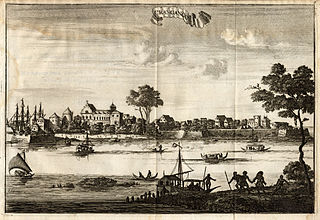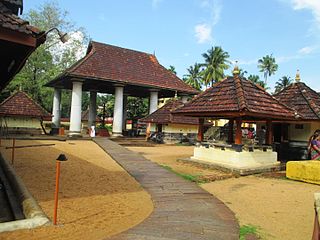
Kodungallur is a historically significant town situated on the banks of river Periyar on the Malabar Coast in Thrissur district of Kerala, India. It is 29 kilometres (18 mi) north of Kochi (Cochin) by National Highway 66 and 38 km (24 mi) from Thrissur. Kodungallur, being a port city at the northern end of the Kerala lagoons, was a strategic entry point for the naval fleets to the extensive Kerala backwaters. It was here that one of Jesus's disciples, St. Thomas reached during 1st century AD to preach Christianity.
Perumal is a medieval Indian royal title.

Ezhimala, a hill reaching a height of 286 metres (938 ft), is located near Payyanur, in Kannur district of Kerala, South India. It is a part of a conspicuous and isolated cluster of hills, forming a promontory, 38 km (24 mi) north of Kannur (Cannanore). The Indian Naval Academy at Ezhimala is Asia's largest, and the world's third-largest, naval academy.

Mushika dynasty, also spelled Mushaka, was a minor dynastic power that held sway over the region in and around Mount Ezhi (Ezhimala) in present-day North Malabar, Kerala, India. The country of the Mushikas, ruled by an ancient lineage of the Hehaya clan of the same name, appears in early historic (pre-Pallava) south India and it is believed that Mushika dynasty has their descents from Heheya Kingdom. Early Tamil poems contain several references to the exploits of Nannan of Ezhimalai. Nannan was known as a great enemy of the pre-Pallava Chera chieftains. The clan also had matrimonial alliances with the Chera, Pandya and Chola chieftains. The Kolathunadu (Kannur) Kingdom, which was the descendant of Mushika dynasty, at the peak of its power, reportedly extended from Netravati River (Mangalore) in the north to Korapuzha (Kozhikode) in the south with Arabian Sea on the west and Kodagu hills on the eastern boundary, also including the isolated islands of Lakshadweep in the Arabian Sea.

The Cheraman Juma Mosque is the first mosque to be built in India. It is a popular pilgrim centre in Kodungallur in Thrissur district. On first glance, Cheraman Juma Masjid resembles a traditional Hindu temple, and this historic spot draws in devotees in large numbers to this day. Built in C.E 629, it is the first mosque in India and the second in the world where Juma prayers were started. Situated just 2 km from Kodungallur town, its calm and mystical charm must be experienced if one is in the vicinity. A legend claims that it was built in 643 CE, which would make it the oldest mosque in the Indian subcontinent which is still in use. It was built on the orders of the successor of Cheraman Perumal, the Chera King of modern-day Kerala. The mosque was constructed in Kerala style with hanging lamps, making the historicity of its date claims more convincing. Other scholars are more skeptical and dated the structure to the 14th-15th century based on the architectural style.

Barkur is an area in the Brahmavara taluk, Udupi district of Karnataka state in India, comprising three villages, Hosala, Hanehalli, and Kachoor. The area is located on the bank of River Seetha. It is also referred to as a "temple town".

Thrissur is the administrative capital of Thrissur District, in the central part of Kerala state, India. Thrissur district was formed on 1 July 1949. It is an important cultural centre, and is known as the Cultural Capital of Kerala. It is famous for the Thrissur Pooram festival, one of the most colourful and spectacular temple festival of Kerala. From ancient times, Thrissur has been politically, economically and culturally significant to the Indian subcontinent. It has opened the gates for Arabs, Romans, Portuguese, Dutch and English. According to tradition, Thrissur is where Christianity, Islam and Judaism entered the Indian subcontinent. Local Christian tradition holds that Thomas the Apostle arrived in 52 CE, and Muslim tradition states that Methala is the location of country's first mosque.

Rama Rajasekhara was a Chera Perumal ruler of medieval Kerala, south India. Rajasekhara is usually identified by historians with Cheraman Perumal Nayanar, the venerated Shaiva (Nayanar) poet-musician of the Bhakti tradition.

Vallikkunnu is a village in Tirurangadi Taluk of Malappuram district in the state of Kerala, India with an area of 25 km2. It is located 5 km north of Parappanangadi town and comes under the jurisdiction of Parappanangadi Police Station and Parappanangadi Judicial First Class Magistrate Court. Its latitude and longitude are 11'07" N and 7'51"E respectively. Vallikkunnu was awarded the best panchayath of Kerala in 1997. Vallikunnu is situated on Tirur-Kadalundi Road. Vallikkunnu is also a part of the Oldest Railway Line of Kerala laid in 1861 from Tirur to Chaliyam via Tanur, Parappanangadi, Vallikkunnu, and Kadalundi.

Kadalundi is a village in Kozhikode district, Kerala, India. It is a coastal village close to the Arabian Sea. Kadalundi is famous for its bird sanctuary, which is home to various migratory birds during certain seasons and has been recently declared as a bio-reserve. The Kadalundi–Vallikkunnu Community Reserve is the first community reserve in Kerala. The Kadalundi River and the Chaliyar river, two of the longest rivers of Kerala, merges with the Arabian Sea at Kadalundi. The first railway line in Kerala was laid in 1861 from Tirur to Chaliyam through Tanur, Parappanangadi, Vallikkunnu, and Kadalundi.

ThiruvanchikulamSivaTemple is a Hindu temple situated in Kodungallur in Thrissur district of Kerala state, India. Constructed in the Kerala style of architecture, the temple is believed to have been built during the Chera period. Shiva is worshipped as Mahadeva and his consort Parvathi as Umadevi. There are 33 sub-deities in this temple, the highest number so in Kerala.

Archaeological Museum, Thrissur is an art and archaeological museum situated in Thrissur City of Kerala state, India. The museum is located in the Thrissur Zoo compound.
Onnu Kure Áyiram Yogam, also called OKAY, is an association of members of the Nair society in the Kodungallur region of Kerala state, India. Literally Onnu Kure Áyiram Yogam means an association of one minus one thousand. The yogam (association) was an organisation of Nairs of the region and various sub classes of the Nair community had representations in the yogam.

Arakkal Kingdom was a Muslim kingdom in Kannur town in Kannur district, in the state of Kerala, South India. The king was called Ali Raja and the ruling queen was called Arakkal Beevi. Arakkal kingdom included little more than the Cannanore town and the southern Laccadive Islands, originally leased from the Kolattiri. The royal family is said to be originally a branch of the Kolattiri, descended from a princess of that family who converted to Islam. They owed allegiance to the Kolattiri rulers, whose ministers they had been at one time. The rulers followed the Marumakkathayam system of matrilineal inheritance, a system that is unique to a section of Hindus of Kerala. Under Marumakkathayam, the succession passes to the male offspring of its female members, in other words from a man to his sister's son and so forth. As the only Muslim rulers in Malabar, they saw the rise of Hyder Ali, de facto ruler of the Mysore Sultanate as the opportunity to increase their own power at the expense of Chirakkal, and invited him to invade Kerala.

Mural Art Museum is the only museum dedicated to mural arts in Kerala. It is situated in Kollengode Palace in Thrissur, India. It was started as a part of Sree Mulam Chithrasala in 1938. Afterwards it was an archaeological museum and in 2009 it was renovated and opened to the public. The museum houses a gallery of murals from all over Kerala and preserves a rare treasure of Veera kallu, temple models, manuscripts written on palm leaves, life-size statues of eminent personalities, a megalith collection consisting of earthen pots, Nannangadi black and red wares, black wares russet coated wares, stone age tools, excavated materials from Indus Valley Civilisation and Harappa and Cheraman Parambu, Kodungallur.
The legend of Cheraman Perumals is the medieval tradition associated with the Cheraman Perumals of Kerala. The sources of the legend include popular oral traditions and later literary compositions. The time of origin of the legend is not known to scholars. It seems the legend once had a common source well known to all Kerala people.
Madayi Mosque is mosque at Pazhayangadi in Kannur district, northern Kerala, India. It is one of the oldest mosques in Kerala, with local legends dating back to the 7th century AD. It is believed to have been established by Malik ibn Dinar and contains a block of white marble said to have been brought from Mecca by ibn Dinar. It is one of the several mosques around Pazhayangadi/Payangadi. It is situated on the banks of Kuppam River, which joins Valapattanam River at its estuary.

Cheraman Perumal Nayanar was a bhakti poet-musician and religious teacher of Tamil Shaiva tradition in medieval south India. The Cheraman Perumal's friendship with Sundarar, one of the 'Three Nayanars', is celebrated in the bhakti tradition. The legend of the Cheraman Perumal is narrated in the hagiographic Periyapuranam, composed by Chekkizhar, a courtier of Chola Kulottunga II, in mid-12th century AD. The collection is based on an earlier work by Nambiyandar Nambi. Thiruvanchikulam Siva Temple in Kodungallur is associated with the Perumal and Chundaramurtti Nayanar.

Cheraman Perumal dynasty, also known as the Perumal dynasty of Kerala, or Chera Perumals of Makotai, were a ruling dynasty in present-day Kerala, South India. Mahodayapuram, or Makotai, the seat of the Cheraman Perumals, is identified with present-day Kodungallur in central Kerala. Initially, their influence appeared limited to the area between present-day Quilon and Quilandy, but later extended to up to Chandragiri river in north Kerala and to Nagercoil in the south.

Perumal is the name of a Hindu deity.














